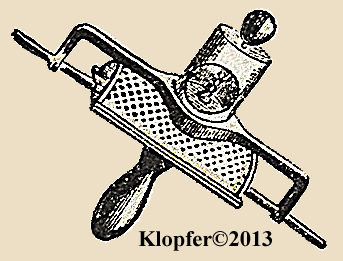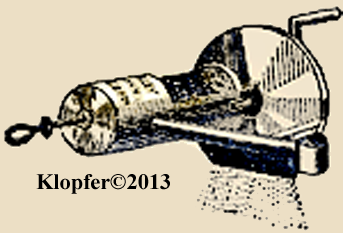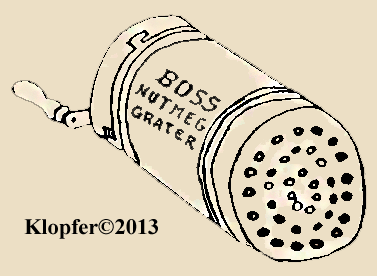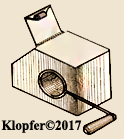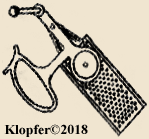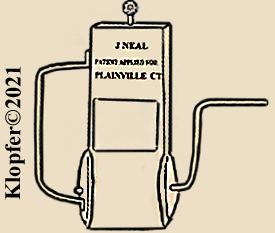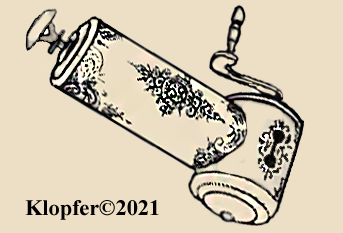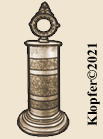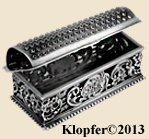 Click Me!
Click Me!
NutmegGraters.Com

- Home
- Featured Stories
- Picture Gallery
- Info.Wanted :
- Spurious Marks
- Trading Post
- Contact Our Site
- Wanted To Buy
[WELCOME: My articles published on NutmegGraters.Com and commercially (elsewhere) required many years of primary research, personal expense, travel and much effort to publish. This is provided for your enjoyment, it is required that if quoting my copyrighted text material, directly provide professionally appropriate references to me. Images are unavailable for copy. Thank you J. Klopfer.]
_______________________________________________________________________________________________________________________________________________________
The Wm. B. Durgin Sterling Nutmeg Grater
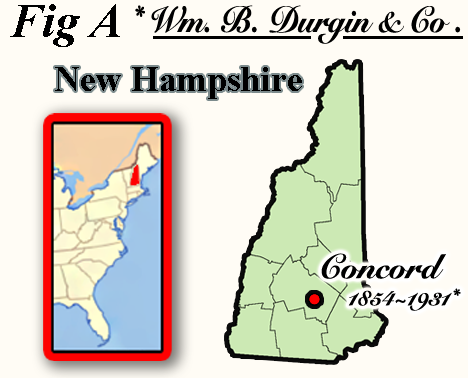 Wm. B. Durgin & Co. were silversmiths located in Concord, NH USA (Fig A), from 1854 to 1931. The company created an extensive line of luxury articles including a distinctive silver nutmeg grater.
Wm. B. Durgin & Co. were silversmiths located in Concord, NH USA (Fig A), from 1854 to 1931. The company created an extensive line of luxury articles including a distinctive silver nutmeg grater.
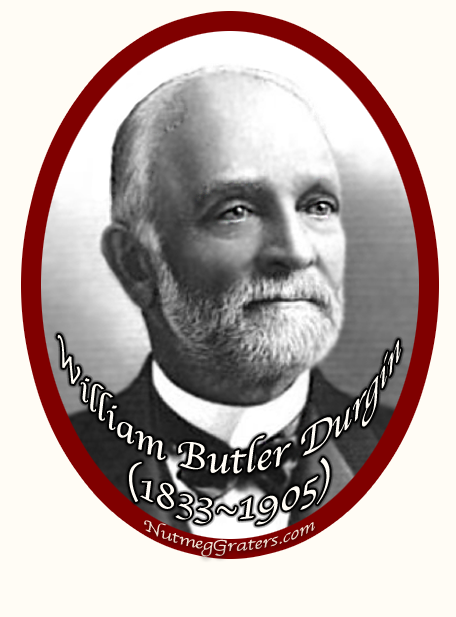
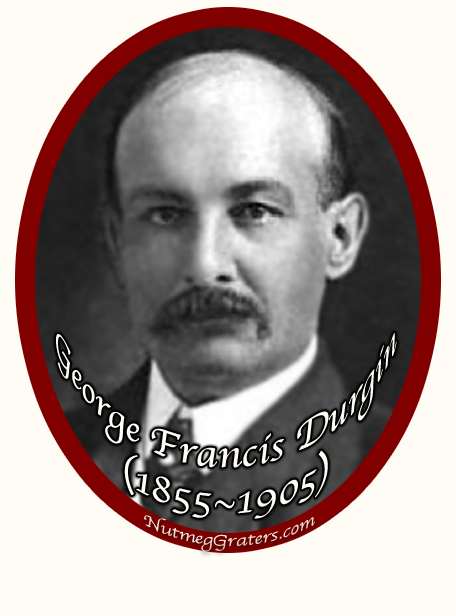
William Butler Durgin (1833~1905) was born and raised on a family farm on the riverbanks of the Pemigewasset in northern Campton, NH. At age 16, William was apprenticed as a silversmith to Harding Newall & Company in Boston, MA. During his apprenticeship (1849~1854), William rose through the ranks to head the company, becoming a skillful master silver craftsman. William gained proficiency down to the smallest detail, both in silversmithing and in business management. He was described as ambitious, tireless, and talented. He possessed both superior trade knowledgable, and an untiring work ethic. 
Reaching his age of majority in 1854, at 21, William returned to Concord, NH, opening his own silver business. Starting in a small one room shop opposite Free Bridge Road, William took on his first apprentice in 1855; the same year his son George Francis Durgin (1855~1905) was born. During his four years at this location, William (with this later addition of his assistant) produced silver spoons which he peddled directly, initially finding various local buyers. Business success continually increased and in 1858 William constructed his first factory in Concord ~ a one story wooden structure located on School Street. Here, William employed a half dozen apprentices and expanded his product line to include all types of silverware. In 1860, the shop was destroyed in a fire among a row of buildings, being soon rebuilt.
In 1867, William relocated his business, constructing a larger facility on School Street in the vicinity near his original factory. This building was celebrated as the first brick structure in Concord. Continually outgrown, the factory was enlarged several times, eventually extending business operation into the vacant space in an adjacent insurance building.
At age 20 in 1878, George F. Durgin joined the firm. Eventually, George become the superintendent and an equal partner with his father. Under its corporate name William B. Durgin & Son, George managed over one hundred and twenty artisans. In a large part, George is credited with production of the company's massive range of artistic and unique hollowware ~ this includes the Durgin nutmeg grater. Through their network of elite retailers, William B. Durgin Co. marketed its silver both in America and Europe.
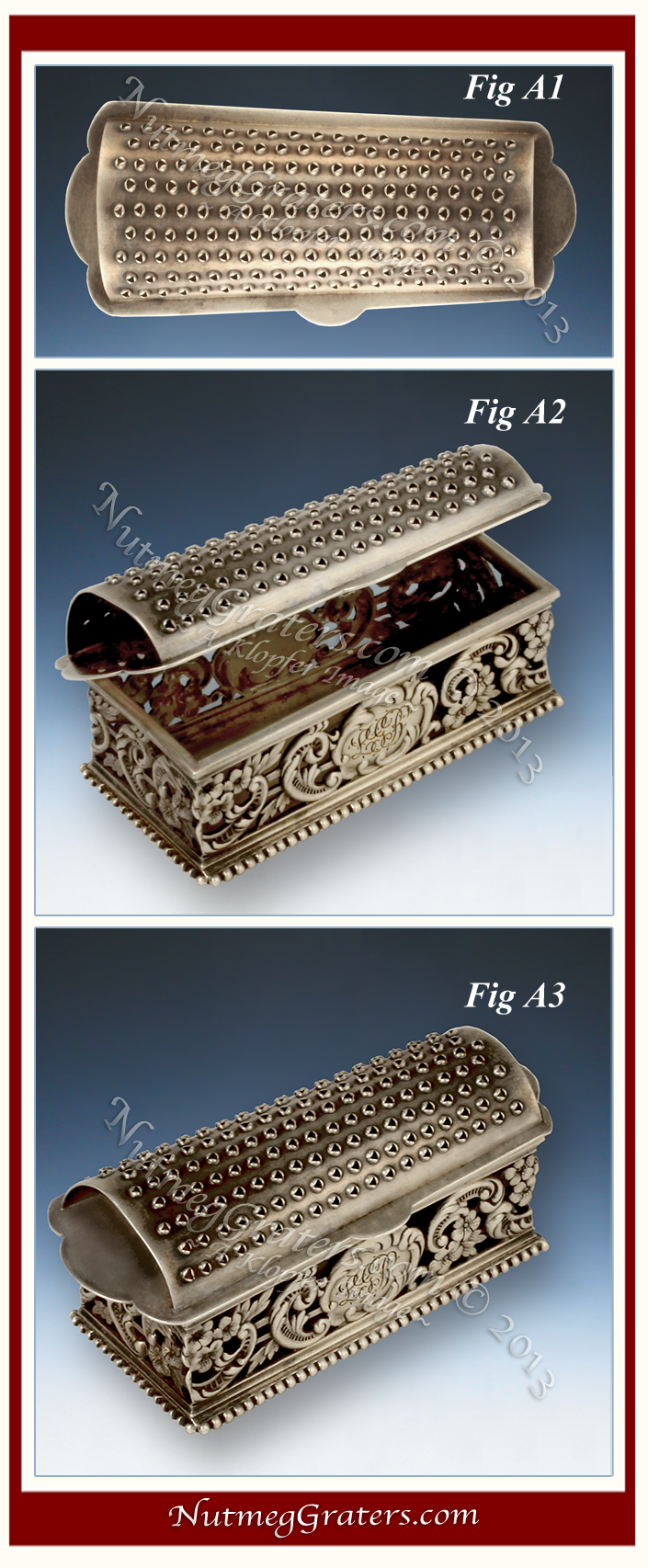 The Wm. B. Durgin & Co. silver nutmeg grater is unique in design. On the lid is a vaulted grater that slightly tapers to one end (Fig A1). The cover hinges to an elegant trapezoidal shaped box below, configuring in formation with its grater on top (Fig A2 open & Fig A3 closed). Each side panel is decorated with delicate cut~away pierced flowers and rococo scrollwork above an applied beaded border. Allowing the option for personalized engraving, there is an ornamental cartouché centered in the front and back panels. On the bottom are four marks: these are the inventory number "1009", the registered house mark representing "Durgin", the mark "sterling" or "sterling silver 925/1000", and the "retailer's mark" (Fig B1~B3).
The Wm. B. Durgin & Co. silver nutmeg grater is unique in design. On the lid is a vaulted grater that slightly tapers to one end (Fig A1). The cover hinges to an elegant trapezoidal shaped box below, configuring in formation with its grater on top (Fig A2 open & Fig A3 closed). Each side panel is decorated with delicate cut~away pierced flowers and rococo scrollwork above an applied beaded border. Allowing the option for personalized engraving, there is an ornamental cartouché centered in the front and back panels. On the bottom are four marks: these are the inventory number "1009", the registered house mark representing "Durgin", the mark "sterling" or "sterling silver 925/1000", and the "retailer's mark" (Fig B1~B3). 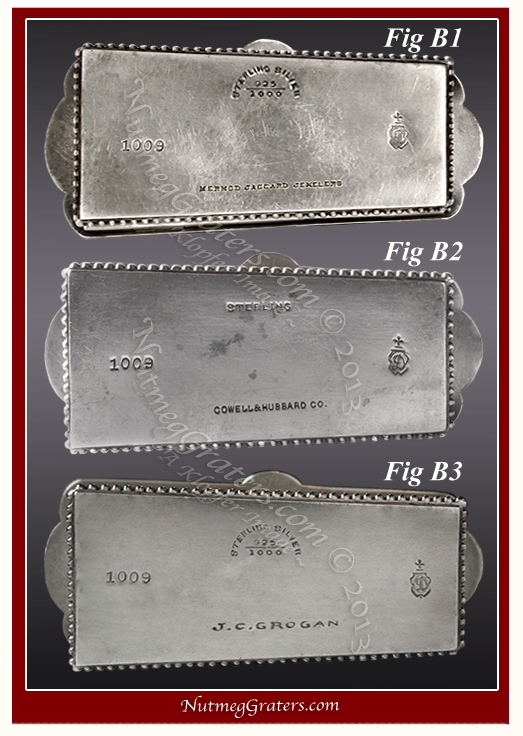
Viewing the "retailer's marks", three sellers of the Durgin nutmeg grater were "Mermod & Jaccard Jewelry Co.", "Cowell & Hubbard Co.", and "J. C. Grogan". From these marks, we determine a possible range in production dates for the Durgin nutmeg graters to fall somewhere between 1883 and 1905. The earlier origination date is based on the Mermod & Jaccard Jewelry Company mark, which was first introduced in 1883 {keep in mind that the J. C. Grogan mark was introduced in 1892, suggestive that the actual production dates may be later than 1883.} A closing production date is based on the Mermod & Jaccard Jewelry Co. mark, which was replaced using Mermod Jaccard & King Jewelry Co. in 1905. [SEE: A short historical account for each of these three retail firms on this page, below.]
During their earlier years, William and Elizabeth (Travers) had married in Boston in 1854, and in the following year built their life long residence on Rumford Street, in Concord. William served as a New Hampshire state representative in 1894. Business being of great financial success allowed the family much time and the means for extended travel throughout the United States and abroad. William and Elizabeth celebrated their golden wedding anniversary September 21, 1904 and in the same year, the family saw the completion of the great, new Durgin factory near beautiful White's Park.
Sadly, William B. Durgin died on May 6, 1905 at the age 71, followed quickly by the death of his son George F. Durgin on May 26, 1905 at the age of 47; both suffering from long illnesses. That same year, the William B. Durgin & Son, Co. was purchase outside the family by Gorham Manufacturing Company, who continued the factory until 1931 when it was closed.
Today, the Durgin silver nutmeg grater remains a scare collectible.
Snapshots: Three Midwestern Retail Jewelry Houses
These three retailers are identified as selling the Durgin nutmeg grater:
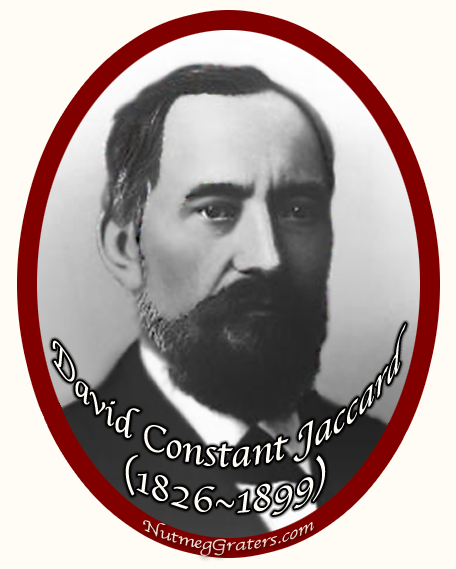 Mermod & Jaccard Jewelry Co. ~ "The largest of its kind in the country!"
Mermod & Jaccard Jewelry Co. ~ "The largest of its kind in the country!"
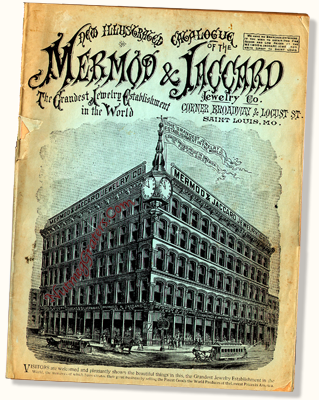 Credited as St. Louis, MI's earliest jeweler, Louis Jaccard arrived there in 1829. Over the next 50 years, this business expanded through various family partnerships. As the result of a business dispute, two of the partners David Constant Jaccard (1826~1899) and Augustus S. Mermod (1822~ 18??) broke away to establish their own firm. First known as D. C. Jaccard & Co. in 1864, it became Mermod, Jaccard & Co. in 1873, and was again renamed in 1883 as Mermod & Jaccard Jewelry Company [this retailer's mark is seen on nutmeg grater (Fig B1)]. Described as "The largest dealers in jewelry and silverware in the Mississippi River Valley", the house maintained its own watch company in Ste Croix, Switzerland and opened several European stores; the first in Paris followed by representation in other major European cities. Achieving great sales success in the United States was the enormous Mermod & Jaccard Jewelry Company Catalog (Circa 1890). This large-layout, hundred page catalog captured buyers throughout the vast Mid~West by advertising jewelry, silver and other luxury goods to consumers who resided within a vast backcountry. Noteworthy, the catalog makes no mention of nutmeg graters. In 1905, the firm became the Mermod, Jaccard & King Jewelry Co.
Credited as St. Louis, MI's earliest jeweler, Louis Jaccard arrived there in 1829. Over the next 50 years, this business expanded through various family partnerships. As the result of a business dispute, two of the partners David Constant Jaccard (1826~1899) and Augustus S. Mermod (1822~ 18??) broke away to establish their own firm. First known as D. C. Jaccard & Co. in 1864, it became Mermod, Jaccard & Co. in 1873, and was again renamed in 1883 as Mermod & Jaccard Jewelry Company [this retailer's mark is seen on nutmeg grater (Fig B1)]. Described as "The largest dealers in jewelry and silverware in the Mississippi River Valley", the house maintained its own watch company in Ste Croix, Switzerland and opened several European stores; the first in Paris followed by representation in other major European cities. Achieving great sales success in the United States was the enormous Mermod & Jaccard Jewelry Company Catalog (Circa 1890). This large-layout, hundred page catalog captured buyers throughout the vast Mid~West by advertising jewelry, silver and other luxury goods to consumers who resided within a vast backcountry. Noteworthy, the catalog makes no mention of nutmeg graters. In 1905, the firm became the Mermod, Jaccard & King Jewelry Co.
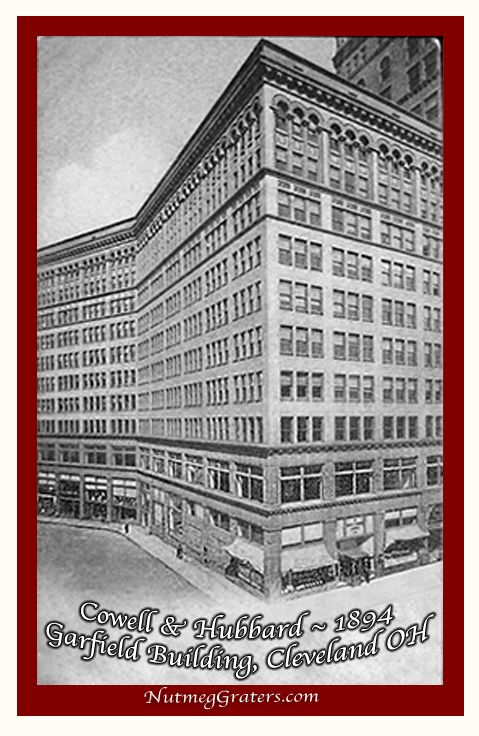
Cowell & Hubbard Co. ~ "Cleveland's oldest jewelry store."
Cleveland silversmiths Cowles & Albertson originated a business about 1849 at 49 Superior Avenue, renamed in 1857 as Cowles & Co. In 1861, George Cowell with his son Herbert procured this business. Operated as H. Cowell & Co., the firm retailed jewelry, silver, lamps, and a full line of fancy goods. After the death of George (the father), Herbert and his brother Samuel continued the business renaming it in 1875 as Cowell Brothers Jewelry Company. Following Herbert's death, Samuel Cowell partnered with the lead jewelry salesman, Addison T. Hubbard in 1879, and the store became Cowell & Hubbard Co. [this retailer's mark is seen on nutmeg grater (Fig B2)]. Samuel Cowell died in 1888. Addison Hubbard is credited as the force behind developing the store's national renown. In 1894, the business moved into the first floors of exclusive Garfield Building at Euclid and Bond where it was characterized as "the finest jewelry store west of the Alleghenies". In 1920, the store moved into its own building at Euclid near 13th. In 1981, the downtown store was closed with remaining branches in several suburban locations.
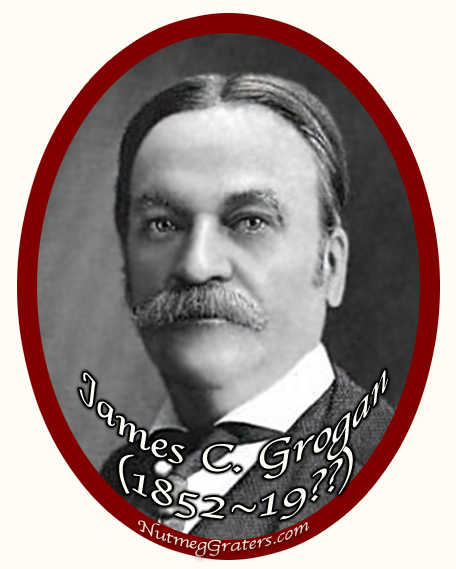
J. C. Grogan Jeweler. ~ "Dealing at retail in silverware, precious stones, watches, jewelry, clocks, fancy goods, and doing generally a retail jewelry business."
Located at Market and 5th in Pittsburg, the J. C. Grogan & Co. name first appears in 1892. Tracing back through a series of owners and name changes, the firm originated in 1840. About 1870, James C. Grogan (1852~ ) entered his career there, at the jeweler's firm of Henry Richardson & Co. Upon Richardson's death, James maintained his position under new ownership, when the business became L. McIntosh & Co. In 1878, McIntosh's died and James Grogan partnered with A. Merz taking ownership of L. McIntosh & Co. Subsequently in 1886, James bought out his partner's interests to become sole owner. Having come up through the ranks, James incorporated his firm under his name J. C. Grogan & Co. in 1892 [this retailer's mark is seen on nutmeg grater (Fig B3)]. J. C. Grogan & Co. was esteemed throughout the jewelry trade, and acclaimed by customers from across the country.
[KLOPFER article © January 2014]
